Saturday 2 September 2006
We
have breakfast with our (British) fellow guests. They are related to each other
and are here for a wedding. After breakfast we take the  Vaporetto
to the Rialto bridge. This Venice's most famous bridge over the Canal Grande.
The bridge itself is lined with (souvenir)shops. From the bridge we have nice
view of the the boat traffic on the canal. We want to start with a coffee and we
think have found the right place: a side walk café next to the bridge. We soon
find out that the café is part of a hotel and that breakfast is in full swing
here. The waitress mistakes us for hotel guests and does not want to charge us
for the coffee. After our free coffee we set out for a walk through the San Polo
and Santa Croce districts. We start at the market near the Rialto bridge. Fresh
vegetables and fruit are sold here, but Vaporetto
to the Rialto bridge. This Venice's most famous bridge over the Canal Grande.
The bridge itself is lined with (souvenir)shops. From the bridge we have nice
view of the the boat traffic on the canal. We want to start with a coffee and we
think have found the right place: a side walk café next to the bridge. We soon
find out that the café is part of a hotel and that breakfast is in full swing
here. The waitress mistakes us for hotel guests and does not want to charge us
for the coffee. After our free coffee we set out for a walk through the San Polo
and Santa Croce districts. We start at the market near the Rialto bridge. Fresh
vegetables and fruit are sold here, but 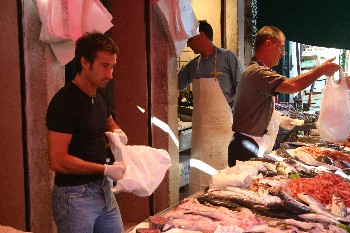 most
stalls sell fish. Fish plays a prominent role in Venetian cooking. Here on the
market its almost exclusively Italian that hear being spoken. This in stark
contrast with the rest of the city. We also see one of the many ferry boats or.
These are gondolas who ferry people across the Canal for a mere 50 cents. Very
handy, because there very few bridges over the Canal Grande. We walk through the
district passing the San Cassiano church, with paintings by Tintoretto.
After that we pass the Santa Maria
Mater Domini, which is unfortunately closed and a bit further down the San Stae.
This one is beautifully situated on the banks of the Canal Grande. Our Venice
Card is not valid because of a special exhibition. We continue to find the tiny S Giovanni Decollato
church or San Zan
Degolŕ in most
stalls sell fish. Fish plays a prominent role in Venetian cooking. Here on the
market its almost exclusively Italian that hear being spoken. This in stark
contrast with the rest of the city. We also see one of the many ferry boats or.
These are gondolas who ferry people across the Canal for a mere 50 cents. Very
handy, because there very few bridges over the Canal Grande. We walk through the
district passing the San Cassiano church, with paintings by Tintoretto.
After that we pass the Santa Maria
Mater Domini, which is unfortunately closed and a bit further down the San Stae.
This one is beautifully situated on the banks of the Canal Grande. Our Venice
Card is not valid because of a special exhibition. We continue to find the tiny S Giovanni Decollato
church or San Zan
Degolŕ in 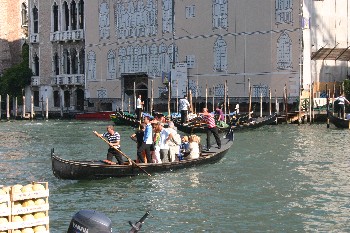 the
dialect. It means the "beheaded St John". It is a tiny 11th century
church, which changed very little since its construction. The frescoes are among
the oldest in the city. Later we get to the S
Giacomo dall'Orio square with the 13th century church by the same name. The
square is a relative oasis of peace and quiet. The place is fairly common
actually. The church is not half bad inside. (Venice Card). Lots of gothic art
and paintings by Verones and others. There is a baptism going when we visit. We
continue through the countless alleyways and over numerous bridges crossing
narrow canals. Then we reach the Frari
church. This part of the district is a lot busier. We getting close to
one of the main tourist arteries between the railway station and the Rialto
bridge. The Frari is a giant church with great paintings. At first we cannot go
in because of a wedding the
dialect. It means the "beheaded St John". It is a tiny 11th century
church, which changed very little since its construction. The frescoes are among
the oldest in the city. Later we get to the S
Giacomo dall'Orio square with the 13th century church by the same name. The
square is a relative oasis of peace and quiet. The place is fairly common
actually. The church is not half bad inside. (Venice Card). Lots of gothic art
and paintings by Verones and others. There is a baptism going when we visit. We
continue through the countless alleyways and over numerous bridges crossing
narrow canals. Then we reach the Frari
church. This part of the district is a lot busier. We getting close to
one of the main tourist arteries between the railway station and the Rialto
bridge. The Frari is a giant church with great paintings. At first we cannot go
in because of a wedding  in
progress. That is why we decide to have some lunch first at the Osteria al Pantalon.
Good food and reasonably priced. Back at the church (Venice Card!) we are
impressed by the altar piece depicting Assumption by Titian. Also Bellini's Madonna
with child and the Saints Nicolas, Peter, Mark and Benedict is magnificent in
its detail and perspective. We are getting tired by now do not waste much time
walking to the Rialto bridge via the San Polo square and the San Aponal church.
We hop on the vaporetto back to the B&B. in
progress. That is why we decide to have some lunch first at the Osteria al Pantalon.
Good food and reasonably priced. Back at the church (Venice Card!) we are
impressed by the altar piece depicting Assumption by Titian. Also Bellini's Madonna
with child and the Saints Nicolas, Peter, Mark and Benedict is magnificent in
its detail and perspective. We are getting tired by now do not waste much time
walking to the Rialto bridge via the San Polo square and the San Aponal church.
We hop on the vaporetto back to the B&B.
We 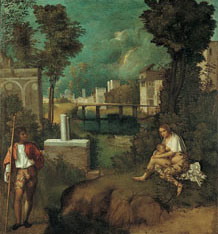 take a break before we go out again to spend part of the afternoon in the Galerie
dell'Accademia. Venice Card is not valid, as this is not a municipal
museum. It has a great collection of Venetian paintings, mostly taken from the
city's chruches. Lots of 14th and 15th century works. Masterpieces are "The
last supper" by Veronese and lots of others by Giorgione, Tintoretto
and Titian. After the visit to the museum we go for a ride in a Gondola. We get in at the official pier near our b&b on the Campo Santa Maria de
Giglio. It costs dearly at €100 for 45 minutes!, but we do it just the same.
The gondolier tells us that an hour is only €125, but we stick to the 45
minutes. It is a special experience to navigate the the narrow canals in the 11
metre long gondola, reaching places you cannot even get to on foot. The low
perspective is quite different than from a vaporetto. We criss cross the S
Marco district via the smaller canals and also include a stretch of the Canal
Grande in our tour passing the Rialto bridge. The gondoliers take rowing into an
art form, which they learned to master after many years of practice. With one
oar and only one oarlock they manage to ply the through the
take a break before we go out again to spend part of the afternoon in the Galerie
dell'Accademia. Venice Card is not valid, as this is not a municipal
museum. It has a great collection of Venetian paintings, mostly taken from the
city's chruches. Lots of 14th and 15th century works. Masterpieces are "The
last supper" by Veronese and lots of others by Giorgione, Tintoretto
and Titian. After the visit to the museum we go for a ride in a Gondola. We get in at the official pier near our b&b on the Campo Santa Maria de
Giglio. It costs dearly at €100 for 45 minutes!, but we do it just the same.
The gondolier tells us that an hour is only €125, but we stick to the 45
minutes. It is a special experience to navigate the the narrow canals in the 11
metre long gondola, reaching places you cannot even get to on foot. The low
perspective is quite different than from a vaporetto. We criss cross the S
Marco district via the smaller canals and also include a stretch of the Canal
Grande in our tour passing the Rialto bridge. The gondoliers take rowing into an
art form, which they learned to master after many years of practice. With one
oar and only one oarlock they manage to ply the through the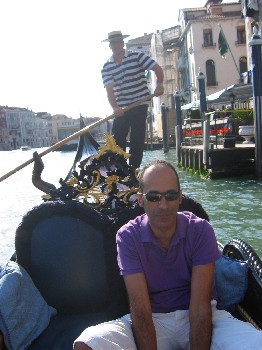 most difficult curves. The gondola's present shape dates back to the 13th
century. Since a decree in 1592 all gondolas are black, 11m long and 1.42m wide
and made out of 300 pieces of wood from various trees.
most difficult curves. The gondola's present shape dates back to the 13th
century. Since a decree in 1592 all gondolas are black, 11m long and 1.42m wide
and made out of 300 pieces of wood from various trees.
 After
the boat tour we go for a glass of Veneto wine at the Al Volta enoteca (wine
bar), the finest in the city. We walk back via the Scala di Bovolo, the
house with the extraordinary exteriour staircase. It is shown on many souvenir
post cards, but very few tourists ever get there. It lies hidden in a tiny court
yard. After
the boat tour we go for a glass of Veneto wine at the Al Volta enoteca (wine
bar), the finest in the city. We walk back via the Scala di Bovolo, the
house with the extraordinary exteriour staircase. It is shown on many souvenir
post cards, but very few tourists ever get there. It lies hidden in a tiny court
yard.
We dine at night in the Dursaduro
district on the banks of the Canale della Giudecca at Alle
Záttere. We are seated on a pontoon with a nice view on the passing
ships and waterbusses.
We walk an buss back to San
Marco and take a night cap in a bar with outside tables.
Weather: sunny 26 degrees
Sunday 3 september 2006
Today is the day for the Regatta Storica.
Every year on the first Sunday of September historical boat races are being held
on the Canal 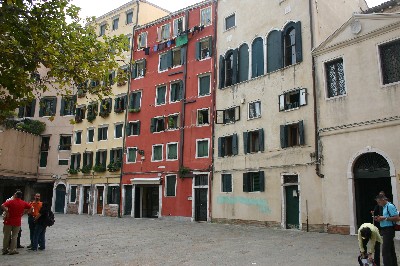 Grande.
The event starts in the afternoon causing a major disruption in the vaporetto network. We
first take the vaporetto to Marcuola. From there we walk to the Ghetto.
The ghetto in Venice has been the jewish quarter since the early 16th century.
All ghettos in the world are named after this district. The word ghetto probably
derives from the Italian wordt geto, which means foundry, which was the
function of this area until 1390. Jews were allowed to practice their religion
freely here and were free from persecution by the Inquisition. However, they did
have equal rights and the ghetto was closed off from sunset till dawn. It was
not until 1797 when the gates to the ghetto were torn down on Napoleon's orders.
At the installation of the Italian monarchy in 1866 Jews were granted full
citizenship. During World War II Italian and Venetian Jews were deported to
concentration camps from 1943 onwards when the Germans took control in Italy.
Now there only a few hundred Jews in Venice, spread over the city. Nevertheless
the ghetto has remained the focal point of the Jewish community here. Here we
find the Jewish museum and there are still half a dozen synagogues, one for each
region the Jews came from. We intend to do a guided walk with a guide, but today
is a European holiday for Jews and the walk has been cancelled. Instead of that
the museum can be visited free of charge, including some synagogues. The
district is guarded by police and volunteers recruited from pensioned
Carabinieri. The area is fairly small. This Grande.
The event starts in the afternoon causing a major disruption in the vaporetto network. We
first take the vaporetto to Marcuola. From there we walk to the Ghetto.
The ghetto in Venice has been the jewish quarter since the early 16th century.
All ghettos in the world are named after this district. The word ghetto probably
derives from the Italian wordt geto, which means foundry, which was the
function of this area until 1390. Jews were allowed to practice their religion
freely here and were free from persecution by the Inquisition. However, they did
have equal rights and the ghetto was closed off from sunset till dawn. It was
not until 1797 when the gates to the ghetto were torn down on Napoleon's orders.
At the installation of the Italian monarchy in 1866 Jews were granted full
citizenship. During World War II Italian and Venetian Jews were deported to
concentration camps from 1943 onwards when the Germans took control in Italy.
Now there only a few hundred Jews in Venice, spread over the city. Nevertheless
the ghetto has remained the focal point of the Jewish community here. Here we
find the Jewish museum and there are still half a dozen synagogues, one for each
region the Jews came from. We intend to do a guided walk with a guide, but today
is a European holiday for Jews and the walk has been cancelled. Instead of that
the museum can be visited free of charge, including some synagogues. The
district is guarded by police and volunteers recruited from pensioned
Carabinieri. The area is fairly small. This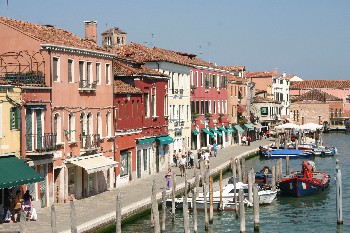 is why overcrowding and the rule that houses were not allowed to be more than
30% higher than houses elsewhere, the appartment floors are quite low in order
to increase the number of stories per building. Most buildings here have 7
floors where 5 would be normal.
is why overcrowding and the rule that houses were not allowed to be more than
30% higher than houses elsewhere, the appartment floors are quite low in order
to increase the number of stories per building. Most buildings here have 7
floors where 5 would be normal.
After the ghetto we walk to the
railway station to make a reservation for tomorrow's train to Verona.  After that we take the vaporetto to the island of Murano. We take
line #41, but that turns out to be an unfortunate choice. This ring line goes
anticlockwise and we have to circle the entire city. #42 goes clockwise and
would have taken us to Murano in less than 30 minutes. After having fully
circled Venice we reach Murano in an hour and a half. The island, cut through by
canals, is famous for its Venetian glass. We eat at a restaurant with an pontoon
on the main canal, followed by a visit to the glass
museum
(Venice Card). It has an interesting collection, covering the history of glass
production and glass art from the Roman days to present. After the visit we are
tempted to buy some glass work as a souvenir. .
After that we take the vaporetto to the island of Murano. We take
line #41, but that turns out to be an unfortunate choice. This ring line goes
anticlockwise and we have to circle the entire city. #42 goes clockwise and
would have taken us to Murano in less than 30 minutes. After having fully
circled Venice we reach Murano in an hour and a half. The island, cut through by
canals, is famous for its Venetian glass. We eat at a restaurant with an pontoon
on the main canal, followed by a visit to the glass
museum
(Venice Card). It has an interesting collection, covering the history of glass
production and glass art from the Roman days to present. After the visit we are
tempted to buy some glass work as a souvenir. .
We take the vaporetto back to
town, where theRegatta
Storica is in full swing. Most vaporettos are out of service, so we
have walk back. We manage to follow a not too busy route. This is not easy, as
the city is loaded with day trippers. Back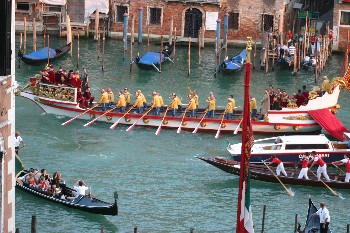 at the B&B we can follow the races from our bedroom window. The
history of the races goes back to the 13th century. The venetian word became the
general term in Europe for rowing contest. The regatta consists of several
races. It starts with a procession of historic boats with crews in period
dress on deck. The first race is for young oarsmen in two
at the B&B we can follow the races from our bedroom window. The
history of the races goes back to the 13th century. The venetian word became the
general term in Europe for rowing contest. The regatta consists of several
races. It starts with a procession of historic boats with crews in period
dress on deck. The first race is for young oarsmen in two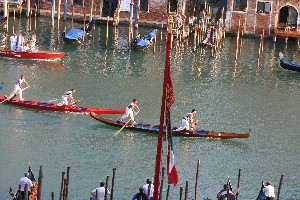 man pupparini. This is followed by the women and finished by the main event: the
men in the gondelini.
man pupparini. This is followed by the women and finished by the main event: the
men in the gondelini.
Around 7.30pm the city returns
to normal and we take line #1 to Ca' Reconiza and walk from there to Casin dei
Nobili, a nice little restaurant, where enjoy a nice dinner. Sea bass with asparagus,
pancakes for dessert. To round off our stay in Venice in style we decide
to take line #1 to the Piazza
San Marco for a drink at the famous caffe Florian
(since 1720). The orchestra plays passionately and we enjoy the Grappa and
Prosecco, while gazing at the passers by and the magnificent square by
night.
Weather: zon, 27 degrees
|
 take a break before we go out again to spend part of the afternoon in the
take a break before we go out again to spend part of the afternoon in the